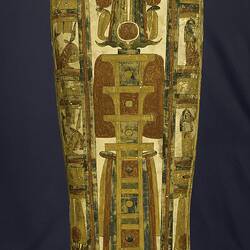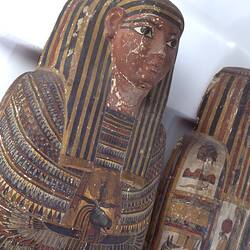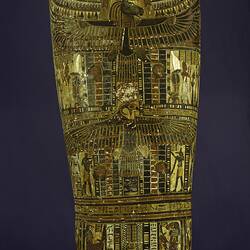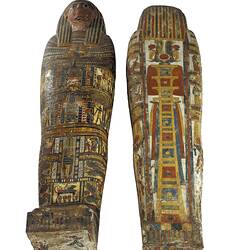Summary
Among the museum's small collection of Mediterranean antiquities are three important items that illustrate how that collection was formed and the perennial fascination with ancient Egyptian attempts to preserve the body to ensure eternal life after death. This includes two mummy cases, one that included the mummy of Tjeby the Elder, and this one that was obtained many decades later.
The decorated wooden coffin of Nytamenkhamun is the only significant Egyptian antiquity to enter the collection in recent times. It was acquired from the collection of J. Bedford, a postmaster at Kyancutta in South Australia who had a small museum. Bedford purchased the coffin in England in 1910 and it was sold in the 1960s, well after his death. Inscriptions on the coffin note that Nytamenkhamun was a seventh century BC minor official in the administration of property owned by the temple of the god Amun at Thebes. The coffin's decoration is shown as though upon the bandages of the body itself, and comprises representations of various gods who ensured the protection of the body.
Physical Description
A wooden coffin consisting of a base and detached lid that is coated with plastered canvas and painted. X79620 is the lid of the coffin.
Significance
The decorated wooden coffin of Nytamenkhamun (sometimes written as Tamenkhamun) is the only significant Egyptian antiquity to enter the collection in recent times. It was acquired from the collection of Robert Arthur Bedford, a postmaster at Kyancutta in South Australia who had a small museum. Bedford purchased the coffin in England in 1910 and it was sold in the 1960s, well after his death. Inscriptions on the coffin note that Nytamenkhamun was a seventh century BC minor official in the administration of property owned by the temple of the god Amun at Thebes. The coffin's decoration is shown as though upon the bandages of the body itself, and comprises representations of various gods who ensured the protection of the body.
More Information
-
Object/Medium
Burial container
-
Maker
-
Locality
-
Date Produced
-
Dimensions
29.5 kg (Weight)
Lid - 16 kg, base - 13.5
-
Previous Owner
-
Keywords
-
Type of item
-
Discipline
-
Category
-
Collecting Areas





